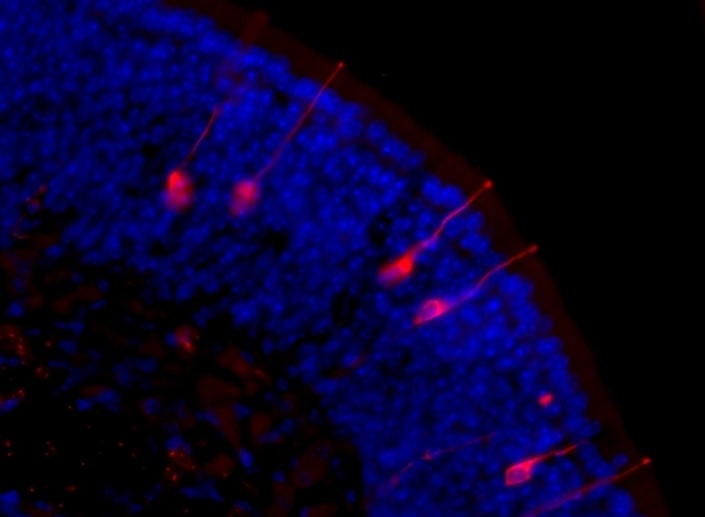


A group of scientists in the state of São Paulo plan to determine whether a sudden loss of smell is an early indication of COVID-19 (image: mouse olfactory epithelium with olfactory neurons in red and cell nuclei in blue / Thiago Seike Nakahara)
Published on 03/23/2021
By Karina Toledo | Agência FAPESP – Preliminary studies conducted in Europe, Asia and the United States suggest that loss of smell is relatively common in people infected by the novel coronavirus SARS-CoV-2. However, is this symptom frequent enough to serve as an early indication of COVID-19? Should people who suddenly lose their sense of smell be advised to self-quarantine in order to not spread the disease? How extensive is the damage done by the coronavirus to the olfactory system, and how long does it last?
A research group in Brazil involving scientists affiliated with the University of São Paulo’s Chemistry Institute (IQ-USP) and the Biochemistry Department at the Federal University of São Paulo (UNIFESP) will try to answer this and other questions as part of a Thematic Project entitled “Odorant receptors: mechanisms of gene expression and signal transduction”, for which the principal investigator is Bettina Malnic.
Focusing initially on the functioning of olfactory neurons and olfactory epithelial cells, in the months ahead the researchers will devote part of their time and effort to an investigation of the correlation between infection by SARS-CoV-2 and the development of anosmia, the technical term for loss of smell.
“The main aim of the project is to study the genes that encode the olfactory receptors [proteins that bind to odorant molecules]. This is a large group of genes expressed only in the cell membranes of the olfactory epithelium. However, in response to the emergency created by the pandemic, we decided to start a remote survey of health workers caring for patients with severe manifestations of COVID-19 and hence at high risk of contracting the virus,” Malnic said.
The group also includes Alexandre Bruni Cardoso, Deborah Schechtman and Isaias Glezer.
A questionnaire will be used to monitor health workers at Hospital das Clínicas, the general hospital run by the University of São Paulo’s Medical School (FM-USP), for the presence of well-established symptoms such as fever, cough and difficulty breathing, as well as olfactory alterations.
Richard Voegels and Fábio de Rezende Pinna, researchers in FM-USP’s Otolaryngology and Ophthalmology Department, are collaborating on this part of the project.
“We want to determine if there’s a pattern in anosmia caused by the coronavirus that distinguishes it from loss of smell due to other causes, such as respiratory tract infections caused by the common cold or flu, or neurodegenerative diseases,” Malnic said. “COVID-19 patients have reported a sudden loss of smell, often with no other symptoms.”
The group also plans to conduct a wider survey similar to one performed by scientists at King’s College London using the COVID Symptom Tracker, a smartphone app used by over 2.3 million people in the UK alone. An initial analysis of the results has shown that loss of smell and taste was reported by 59% of people who tested positive for the virus and 18% of those who tested negative.
If this first stage of the investigation reveals sufficient evidence to confirm a correlation between SARS-CoV-2 and loss of smell, the group will extend the analysis to try to understand how the virus affects the functioning of the olfactory epithelium.
“One possibility would be to analyze samples from infected patients and see if the structure of the olfactory epithelium is altered in these individuals,” Malnic said. “We could use in situ hybridization [a technique that detects target mRNAs in individual cells in a section of tissue] to determine whether olfactory neurons survive infection.”
Experiments with cultured cells and animal models may also be conducted to understand how the virus acts on the olfactory epithelium. However, mice and other mammals used in this kind of experiment do not usually contract SARS-CoV-2. “A mouse strain has been genetically modified to express human ACE-2, the protein used by the virus to invade cells. We could investigate whether these animals exhibit alterations to their olfactory system when infected by the virus,” Malnic said.
Source: https://agencia.fapesp.br/33225